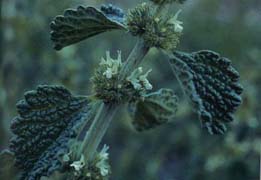Mixed forest A is divided almost in half by a woodchip trail, most of the site lies on flat land, which slopes up slightly on the side of the trail farthest from the Longhouse. This forest habitat is prominently filled with evergreen trees and sword fern, though it also contains a few deciduous trees. The understory directly beneath the trees is almost entirely covered by ivy, which is beginning to climb up a couple of the trees. After the curve in the path, the inner corner of our site (closest to the longhouse) is lush with multiple types of small, low-growing herbaceous plants. The understory contains many low-growing bushes including Oregon Grape, Salmonberry, and Salal.
In late fall, many types of mushrooms and fungi appear due to the moist and dark conditions. Some of these grow directly from the ground, while others are growing from decaying logs.
Mixed Forest B is primarily a deciduous forest with many Alder and Maple Trees dominating the area. The Red Elderberry struggles through the summer when little moisture is available, which demonstrates how difficult it can be for parts of the forest to survive through drought. This area also has plenty of Oregon Grape, Salal, Sword Fern as well as Vine Maple, all of which create the understory in this forest. We have hopes to plant some Beaked Hazel, which grows well with the Red Elderberry and well as some Fireweed, and Evergreen Huckleberry which aid the growth of the Salmonberry which is also present in our site. .
Lauren, Suzanne, Derek, Alina
Draft Signage for Forest B
Forests, like many other living organisms grow, and recede in cycles, moving from barren yet nutrient rich soils of a forest newly burned or destroyed (logging or natural disaster etc.) to, with time, creating old growth forests containing distinct layers of plants; ground covers, herbaceous plants, shrubs, under and over stories. This site, Forest B, represents a forest in its beginnings; 10-15 years after an event such as a forest fire or logging has taken place removing old growth conifers. What is particularly characteristic to this site are the Red Alder (Alnus rubra), Big-Leaf Maple Trees (Acer mycophyllum), Red Huckleberries (Vaccinium parvifolium), and Vine Maples (Acer circinatum). The Alders, Big-Leaf Maples and Red Huckleberries are known to thrive in areas of transition.
Red Alders are a short lived, shade-intolerant pioneer with rapid juvenile growth and the ability to fix atmospheric nitrogen. The soil disturbance generated by logging, log landings, skid trails, or avalanche paths exposes mineral soil, inviting the deciduous species to put down roots to form both pure and mixed stands. Another important part of the Alder’s existence in this forest is its relationship with other herbaceous plants. The Red Alder increases the understory plant biodiversity providing more food for nearby birds and animals. Common shrub associates (some of which are pre-existing and some of which will soon be planted) are the wine maple, Oregon grape, Devils Club, Salmon berry and Western Thimble berry. Common herbaceous associates to the red alder are the sword fern, lady fern, blackberries, stinging nettle, and Oregon oxalis.
The Vine Maples too occur most frequently on moist soils, rich in nitrogen, particularly along the banks of streams and wet sites. It can live in the shade but also occurs in openings in the forest. Both the Vine Maple and Alder are often the first trees to establish after landslides.
The Red Elderberry (suffering here due to lack of available water in the summer months) grows well in cool, shaded areas surviving often in poor soil condition while providing extensive root system which helps to prevent soil erosion. The Elderberry is another plant that fosters a bountiful habitat for birds and small wildlife that take refuge in the Elderberries thick tangle of branches.
In hopes to provide a fuller example of this ever-changing forest, we would like to see some thimbleberry, beaked hazelnut, quaking aspens and other native species added to this site to emphasize the biodiversity our larger more established trees bring to a thriving new forest.
